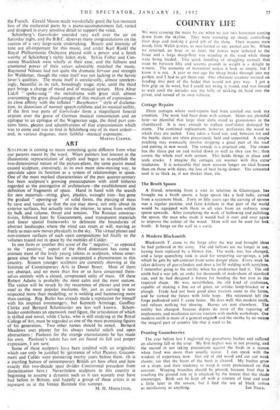ART
SCULPTURE is corning to mean something quite different from what our parents meant by the word. When painters lost interest in the illusionistic representation of depth and began to re-establish the two-dimensional nature of the picture-plane, the same purist mood caused sculpture, conversely, in its own more slow-moving way, to speculate upon its function as a system of relationships in space. One of the most marked characteristics of the past quarter-century has been sculpture's growing preoccupation with aims hitherto regarded as the prerogative of architecture—the establishment and definition of fragments of space. Hand in hand with the search for new materials—string, glass, plastics, wrought iron—has gone the gradual " opening-up " of solid forms, the piercing of mass by cave and tunnel, so that the eye may move, not only about its exterior surfaces, but actually into the interior, to sense from within its bulk and volume, thrust and tension. The Russian construc- tivists, followed later by Giacommetti, used transparent materials and linear spatial frameworks to delineate the boundaries • of abstract landscapes, where the mind can roam at will, moving as freely as man now moves physically in the sky. The virtual planes and non-existent surfaces of such open compositions led finally to the volumes traced out in space by the mobiles of Calder.
In one form or another this sense of the " negative," as opposed to the " positive," aspect of the third dimension has come to animate most of the lively young talents in sculpture, whose emer- gence since the war has been so unexpected a phenomenon in this country. Sixteen younger sculptors are currently showing at the Institute of Contemporary Arts in Dover Street. Most of them are abstract, and no more than five or so have concerned them- selves entirely with a closed, compressed unity of mass. Of these Robert Adams is probably the most calm and the most mature. The visitor will be struck by the recurrence of plaster and iron or steel as the most popular mediums, for, just as carving is now respected more than modelling, so is welding and hammering more than casting. Reg Butler has already made a reputation for himself with his inspired ironmongery, but Kenneth Armitage, Geoffrey Clarke and Bernard Schottlander are less well known. Schott- lander contributes an openwork steel figure, the articulation of which is skilled and novel, while Clarke, who is still studying at the Royal College of Art, must be regarded as one of the most promising figures of his generation. Two other names should be noted. Bernard Meadows uses plaster for his always tasteful reliefs and open abstractions ; Paolozzi for the strange encrustations he has made his own. Paolozzi's talent has not yet found its full and proper expression, I am sure. Some of these sculptors have been credited with an originality which can only be justified by ignorance of what Picasso, Giacom- metti and Calder were pioneering twetty years before them. (It is a startling feature of contemporary British art how often and how exactly this two-decade span divides Continental precedent from domestication here.) Nevertheless sculpture in this country is beginning to assume a dynamic such as it can scarcely ever have had before in Britain, and happily a group of these artists is to represent .us at the Venice Biennale this summer. M. H. MIDDLETON.


































 Previous page
Previous page